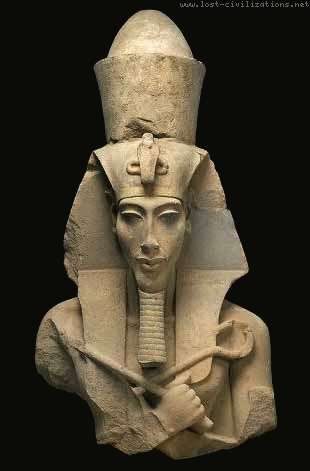
Akhenaten, whose name meant "Effetive Spirit of Aten", known as a philosopher and a thinker was pharaoh during Egypt's eighteenth dynasty. He promoted a view of the world that challenged the foundations of Egyptian belief. One of the most profound things that he did as pharaoh was to revolutionize religion; specifically compelling the Egyptian population to monotheism towards the god Aten. He also made major changes in acient Egyptian art, moved the capital of Egypt from Thebes to el-Amanna, and presented himself in a way that differed from any of his predecessors.
Akhenaten's reign lead to the reform of Egyptian art, which once had strict rules about how to draw people and what colors should be used. Under Akhenaten, a new, more natural approach was developed.(Clayton 124) One of the most unusual results of the art reformation was the depiction of the physical characteristics of Akhenaten himself. In many sculptures and paintings, he is shown to have a long neck and face with a sharp chin, narrow almond-shaped eyes, as well as a rounded stomach. According to the most popular belief, he suffered from Froehlich's Syndrome. It is also believed that the way he looked was some form of religious symbolism. It has been suggested that he was made to look this way in artwork as a representation of the god Aten.
The nature of Akhenaten's religious revolution was well established and clearly portrayed as he overthrew Egyptian polytheism in favor of worship of the single god Aten. His religion did center on one god, but the major importance was on Aten's visibility, tangibility, and irrefutable actuality; Akhenaten put no emphasis on faith. His religious revolution is viewed as a turning point in Egypt's belief system. This is because he turned away from polytheism and replaced it with monotheism, which was unheard of at that time. Akhenaten could implement this change because pharaohs ran the country and the church and opposition was not an opinion.(Shuter 27) However, this quickly diminished when his reign as pharaoh ended.
Another significant time in Egyptian history when Akhenaten was pharaoh was known as the Armana Period. He left Thebes with his family and moved to a new capital located in Middle Egypt, which was half way between Memphis and Thebes. He did this because he had a vision wherein he saw a sun disc between two mountains with the god Aten appearing in the sun disk, indicating the light. It was from this that he felt guided to build a new city bewtween the two mountains. When traveling 180 miles north of Thebes to the location, he discovered that the site had not been dedicated to any other gods or goddesses and this persuaded him to name it Akhenaten-The Horizon of the Aten. He then built an entire city devoted to Aten; complete with a necropolis and royal tomb. Work began on this new city in 1346 B.C. and was complete in 1344 B.C.
Akhenaten neglected foreign policy and showed little interest in keeping its borders safe. Akhenaten has been portrayed as a pharaoh who wanted to make everyone content, and in doing so tried to create a beautiful, optimistic religion and utopian place to live, while paying little attention to serious matters. History has been more realistic about the actuality of his reign and described Akhenaten as not living within the reality of his worshippers.(Stalcup 145) Around the eighteenth year of his ruling, in the year 1334 B.C., Akhenaten died with the circumstances never fully explained.
Akhenaten had a major influence through the reforms he made during this remarkable period in history. Some scholars have suggested that Akhenaten's reforms were the first genuine scholarly revolution in recorded history.(Silverman 129) What has been clearly shown is that Akhenaten's ideas were not accepted by most Egyptians. Through the course of history, what can be gleaned and memorable is that Akhenaten's changes affected most aspects of Egyptian culture even though his intellectual revolution seemed doomed to failure after his death.
Clayton, Peter A. Chronicle of the Pharoahs. New York: Thames and Hudson,
Ltd., 1998.
Shuter, Jane. Ancient Egypt. Austin, Texas: Steck-Vaughn Company, 2001.
Silverman, David P. Ancient Egypt. New York: Oxford University Press, 1997.
Stalcup, Brenda. Ancient Egypt Civilization. California: Greenhaven Press,
Inc., 2001.
1 comment:
Yeah, that is what I expected. Well Done.
5,5,5
Post a Comment